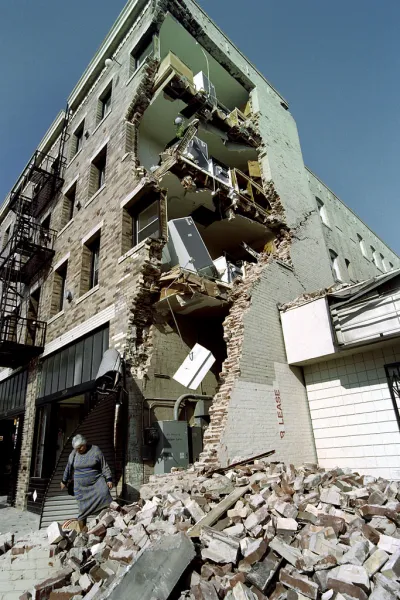Decades in the making, the Los Angeles City Council has approved regulations requiring the retrofit of vulnerable wood and concrete buildings.

Last week, the Los Angeles City Council voted unanimously to require that 15,000 buildings across the city be retrofitted to withstand the shaking caused by earthquakes, reports Rong-Gong Lin II, Rosanna Xia, and Doug Smith of the Los Angeles Times. The new regulations give property owners five years to upgrade wood buildings and 25 years to upgrade concrete buildings in order to prevent the type of building collapse that was most recently seen in the 2011 earthquake that struck Christchurch, New Zealand. The unknown remains how the retrofitting will be paid for, and by whom.
“The City Council is still mulling exactly how the retrofit costs will be shared. The law currently allows owners to increase monthly rents by up to $75 to pay for required earthquake retrofits, but both sides say they do not think Los Angeles renters can afford such a hike…
To help pay for the costs, apartment groups are looking for additional financial support, such as breaks on property and state income taxes and business license and building permit fees for owners who retrofit.”
The Times report states that the city will begin sending out notices to some 13,500 owners of wood buildings next month, with the owners of 1,500 concrete buildings being contacted at a later date. The cost to upgrade a single concrete building could approach close to $1 million.
FULL STORY: Los Angeles will have the nation's toughest earthquake safety rules

National Parks Layoffs Will Cause Communities to Lose Billions
Thousands of essential park workers were laid off this week, just before the busy spring break season.

Retro-silient?: America’s First “Eco-burb,” The Woodlands Turns 50
A master-planned community north of Houston offers lessons on green infrastructure and resilient design, but falls short of its founder’s lofty affordability and walkability goals.

Delivering for America Plan Will Downgrade Mail Service in at Least 49.5 Percent of Zip Codes
Republican and Democrat lawmakers criticize the plan for its disproportionate negative impact on rural communities.

Test News Post 1
This is a summary

Test News Headline 46
Test for the image on the front page.

Balancing Bombs and Butterflies: How the National Guard Protects a Rare Species
The National Guard at Fort Indiantown Gap uses GIS technology and land management strategies to balance military training with conservation efforts, ensuring the survival of the rare eastern regal fritillary butterfly.
Urban Design for Planners 1: Software Tools
This six-course series explores essential urban design concepts using open source software and equips planners with the tools they need to participate fully in the urban design process.
Planning for Universal Design
Learn the tools for implementing Universal Design in planning regulations.
EMC Planning Group, Inc.
Planetizen
Planetizen
Mpact (formerly Rail~Volution)
Great Falls Development Authority, Inc.
HUDs Office of Policy Development and Research
NYU Wagner Graduate School of Public Service




























